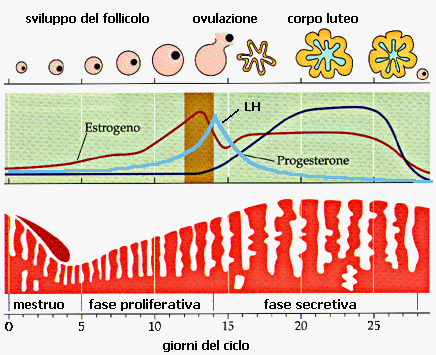The menstrual cycle consists of four phases:
Simple list:
- point one Menstruation: the endometrium begins to lose the accumulated liquid and flakes off, the bleeding appears
- point two Follicular phase: the concentration of estrogen increases and this causes the thickening of the endometrium
- point three Ovulation: the follicle bursts and releases the mature egg in the Fallopian tubes
- point four Luteal phase: the follicle becomes the corpus luteum and produces progesterone, thus the thickness of the endometrium increases further.

There are few works related to the trend of sodium during the menstrual cycle and its possible role in the premenstrual syndrome,
O’Brien and his team studied the cycle in 28 women: 18 with premenstrual syndrome and 10 who were symptomless (control group).
They noted that the mean 24-hour urinary sodium excretion in the group with symptoms was lowest during the preovulatory phase and highest during the postovulatory phase, but the results were similar in the control group.
Also the 24-hour urinary volume and the sodium / potassium ratio suggest a natriuresis and diuresis consequent to the secretion of progesterone, and then in the premenstrual phase occurs a water and sodium retention.
Progesterone acts as a natriuretic agent through its inhibition of aldosterone at the renal distal tubule. The changes appeared greater in the women with symptoms of premenstrual syndrome, but only those at the higher concentrations of progesterone were confirmed statistically.
Progesteron, fluid, and electrolytes in premenstrual syndrome. 1980
Mira and his collaborators studied 20 subjects. The sample (blood) were collected in the luteal phase and in the follicular phase. The only significant differences that they found were for the mean concentrations of sodium and uric acid in plasma, which were lower in the luteal phase than the follicular phase. Thus it appears that sodium is lost in excess of water in the period after ovulation.
In this case they reported that changes in progesterone concentration were not correlated with the changes in plasma sodium during menstruation, possible causes for this change is the increased concentrations of antidiuretic hormone in the luteal phase, or of other hormone that were not measured in this study.
Changes in Sodium and Uric Acid Concentrations in Plasma during the Menstrual Cycle. 1984
To study the relation between menstrual cycle symptoms and sodium balance in normal women, Olson and her collaborators changed sodium balance by decresing intake of sodium by 30% for 2 months.
Plasma sodium level were significantly lower in the luteal phase than in the follicular phase, they decreased in the baseline cycle and in the salt-restriction cycle. Retention of urinary sodium was not seen in any cycle period. An increase in urinary sodium excretion was seen during mid-luteal phase of the salt –restriction cycle
They found no evidence of urinary sodium retention and paradoxically sodium loss was seen during the luteal phase in the first month of the sodium-restricted diet, despite biochemical evidence of extracellular fluid volume contraction.
It seems that the menstrual symptoms studies are unrelated to sodium balance.
Relation between Sodium Balance and Menstrual Cycle Symptoms in Normal Women, 1996
In a study of Lazúrová at al. 12 healthy women were examined using the 2-hour’s method of passive leg rising in follicular and luteal phases of normal ovulatory cycle.
There were no significant differences in the baseline urinary volume, sodium excretion , potassium excretion and urinary osmolarity. Urinary sodium excretion did not correlate with plasma estradiol or progesterone. Moreover no correlation was detected between sodium excretion and plasma rennin activity or aldosterone respectively.
A study of the renal sodium excretion during the normal menstrual cycle using method of passive leg rising, 1999
Studies in vitro were performed with cultured tubular cells and these trends were observed.
Estrogen and/or progesterone increase epithelial sodium channels activity.
Low concentration estrogen together with progesterone stimulated ENaC activity more than 2-fold. A high concentration of estrogen almost completely inhibited stimulated ENaC activity. The observed change correlated to the hormone change during the luteal phase. The elevation of estrogen and progesterone during the mid-luteal phase inhibited ENaC activity. Decline of estrogen production during the late luteal phase prevented the inhibitory effect. ENaC activity was enhanced and might explain observed pre-menstruation edema.
Interaction of Estrogenand Progesterone in the Regulation of Sodium Channels in Collecting Tubular Cells, 2007
In conclusion from these articles, it is deduced that the sodium tends to decrease during the follicular phase, while it increases during the luteal phase. The hormone that mainly affects the sodium balance is progesterone, but it would appear that premenstrual symptoms are not correlated with a deficiency of sodium.
For more info on factors affecting Sodium metabolism see Serum sodium